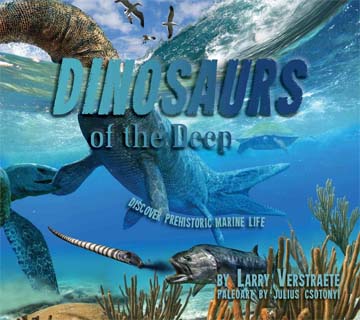| ________________
CM . . .
. Volume XXIII Number 8. . . .October 28, 2016
excerpt:
Well-researched, thorough and highly engaging, this fascinating book examines the creatures that flourished in the Western Interior Seaway about 70 million years ago. Though the creatures are actually classified as marine reptiles, Verstraete intentionally chose the word “dinosaurs” in the title “to connect with readers, evoking a sense of the time, place, and fascination that is often associated with the word”, and then used the subtitle to clarify the book’s content. During the Cretaceous period, what is now the Plains region of Canada and the United States was covered by a warm, salty sea. The book’s first of four chapters explains how the sea was formed, how scientists glean evidence about the Earth’s past from the types and distribution of rocks and the climate and conditions that existed at the time. A double-page spread highlights important discoveries related to geology and marine paleontology, an example of which occurred in 1974 when a farmer in the Morden, MB, area found what he thought to be a fence post in his pasture. The fence post was actually a fossilized jawbone of a mosasaur, and, upon further investigation, a 13-metre long Tylosaurus was excavated. The second chapter features fossil formation and the processes involved, not only in an archaeological dig, but also in the reconstruction of a dinosaur skeleton. This chapter is particularly interesting for a number of reasons: firstly, the author clearly explains the various types of fossils and the ways in which they are formed – from true form fossils (bone turned to stone) to mummification, amber preservation, molds, casts and others; secondly, he discusses how scientists obtain information from the examination of bones, teeth, tracks, coprolite (dung) and eggs, and how fossils can reveal facts about the evolution of Earth; and finally, he provides, in detail, the steps taken by paleontologists to bring fossils safely from the field to the lab. Extracting clues back at the lab involves, but is not limited to, CT scans of the dinosaur’s skull, studying attachment scars on fossilized bone and skin pigments left on rocks, and creating computer generated models. Readers are also given a behind-the-scenes look at a fossil museum and learn about the two methods (relative and absolute dating) used to determine a fossil’s age. The third chapter focusses on specific examples of life in the Western Interior Seaway. These include mosasaurs, ichthyosaurs, plesiosaurs, fish, turtles, sharks, birds, crocodiles and invertebrates. There are several examples of each with information about the creature’s name, size, range and special features. The last chapter provides some theories about dinosaur extinction as well as brief anecdotes about everyday people from different parts of Canada and the United States who, quite by accident, made important dinosaur discoveries. For instance, a father and his young daughter in Courtenay, B.C. happened upon some fossilized bones which turned out to be the almost complete remains of an 80 million-year-old marine reptile, the first Elasmosaur discovered in British Columbia. Finally, there are tips for fossil hunters on rules and regulations surrounding fossil collection and a list of museums and science centres along the Western Interior Seaway which house Cretaceous fossils. Verstraete’s engaging writing style draws readers in and sustains their interest throughout the book. His use of analogies, examples and anecdotes, coupled with well-researched facts explained in kid-friendly language, are a winning combination. Maps, a timeline, drawings and abundant colour and black-and-white archival photographs not only add greatly to the reader’s understanding of the topic, but also provide visual appeal. A table of contents, a glossary, an index and a list of books, websites and online magazines with articles about paleontology and prehistory are included. Educational, engrossing and exceptionally well-written, “Dinosaurs” of the Deep is a definite “must have” for dinosaur buffs and library and school collections. Highly Recommended. Gail Hamilton is a former teacher-librarian in Winnipeg, MB.
To comment
on this title or this review, send mail to cm@umanitoba.ca.
Copyright © the Manitoba Library Association. Reproduction for personal
use is permitted only if this copyright notice is maintained. Any
other reproduction is prohibited without permission.
Next Review | Table of Contents For This Issue - October 28, 2016 |
